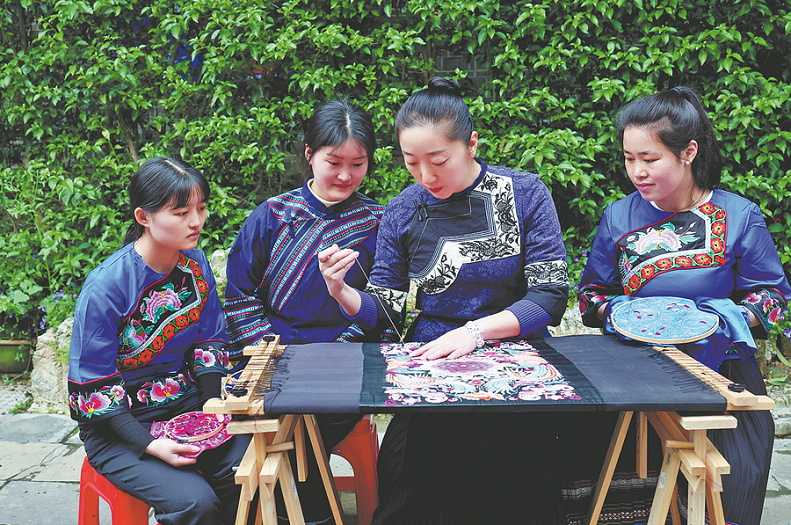

Embroidery skills allow Miao people from Hunan province to bring delicate needlework alive and enable visitors to have an interactive experience with traditional ethnic culture during their stay, Yang Feiyue reports.
Seen from afar, low-rise buildings featuring white walls and gray tiles huddle together amid stretchy green farmlands across which a river meanders through a valley.
On both sides of the valley, mountains covered by lush trees reach up to the sky, blocking the outside chaos and bringing a pastoral and tranquil vibe.
It is the first impression one gets when arriving at Zhonghuang village, Jishou city, Xiangxi Tujia and Miao autonomous prefecture, in Central China's Hunan province.
The village boasts a history of more than 700 years and is home to mostly ethnic Miao people and over 60 distinctive folk houses that were built on stilts of different heights beside the river or in steep mountain areas.
This stunning view and profound ethnic heritage has prompted Yi Hua to tap into her expertise in Xiang embroidery and add to the rural charm to draw in visitors and boost tourism.
"All the rural architecture and natural landscape scenery has been very well preserved," says Yi, who was born in the prefecture and has practiced Miao embroidery for more than a decade.
However, due to lack of industrial development, many young people used to leave home to make a living in the cities, leaving their elderly parents and children behind.
The village conditions are perfect for what Yi has been doing in recent years — carrying forward ethnic culture, especially Miao embroidery.
That was why she and her team started to work on the design and tourism operations of the village last year.
"We hope to retain the village's existing scenery and ethnic images, and industrialize Miao embroidery, batik and cloth-weaving in the village to revitalize traditional ethnic culture," Yi says.
The goal is to enable visitors to have an interactive experience with traditional ethnic culture during their stay in the village and thus feel the place is "a home away from home", Yi adds.
Yi has given Miao embroidery training to local villagers, who are now wearing Miao costumes daily and can be spotted weaving with old-fashioned wooden looms or embroidering traditional animals and plants patterns on dark blue cloth.
Yi and her team are also working to develop an ethnic intangible cultural heritage corridor in the village that will open to the public this summer vacation.
In addition, more Miao elements have been applied to the overall village renovation.
"For example, the butterfly is an important totem of the Miao people, and it symbolizes motherhood and love, so we have made a point of integrating butterfly elements in local architectural design," Yi says.